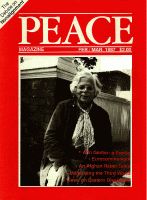
Peace Magazine Feb-Mar 1987, page 39. Some rights reserved.
Search for other articles by Shirley Farlinger here
Gwynne Dyer, Tina Viljoen (producers). National Film Board of Canada 1985
Gwynne Dyer and Tina Viljoen are at it again. First it was War, the seven-part National Film Board documentary, then the three-segment Defence of Canada and now Harder Than it Looks. In just 28 minutes this National Film Board documentary wraps up the argument that alliances are dangerous and Canada might better look at ways of keeping the superpower blocs apart.
"I would be astounded if NATO was still there fifteen years from now," Dyer states. "The alliance is disintegrating. The question is how to dismantle NATO without the U.S. feeling betrayed. The Warsaw Pact could dissolve too. The Russians have pulled out of more places than the U.S. since World War II," he notes.
Although it may indeed be harder than it looks, Tina and Gwynne maintain that no academic study has yet looked at the actual costs. It may be cheaper than it seems. Even a company like Spar Aerospace might be interested, says Dyer, because today the present benefits of military work don't come back to Canada.
The film looks at the Arctic Circle countries and links the need to preserve the ecology of the Arctic with the strategy of demilitarizing it and providing a buffer zone. To explain the premise, Dyer uses the familiar shots of talking heads, such as George Ignatieff, President of Science for Peace, Maj-Britt Theorin and Inge Thorssen, Europe's foremost spokeswomen for disarmament, and William Arkin, U.S. arms analyst.
It is Geoffrey Pearson who questions forcing a position of neutrality on Canada it has never had. As Dyer says, "Nothing happens overnight. We just want this to become part of the discourse.... It would need to be more than one party's platform," he advises.
The film looks at all the nonaligned Nordic countries and suggests that they cooperate with a nuclear free zone. While recognizing that these countries have a tradition of neutrality that Canada lacks, Dyer points out that Prime Minister Mackenzie King was a secret neutralist trying to keep Canada out of foreign wars. Because the United States might not provide arms to a neutral bloc, we might have to follow Sweden's example and manufacture our own. You can't argue with success: Sweden has enjoyed 170 years of peace. Dyer sees neutrality not as withdrawing from the world but as taking responsibility for the world and for ourselves.
The film was launched at the Edmonton conference, The True North Strong and Free? and people responded by admitting that they had been half thinking along similar lines but were afraid to mention it in public, Dyer says.
Harder Than it Looks is one of 25 films requested by the United Nations Information Office to mark the International Year of Peace. These have been completed by 25 countries with no money or editorial control from the U.N. The NFB has the right to distribute them, but not all will be shown here.
Dyer and Viljoen will take the film across Canada, giving interviews as they go. If Harder Than it Looks becomes as popular as War and The Defence of Canada, we can expect more from this determined duo.

Peace Magazine Feb-Mar 1987, page 39. Some rights reserved.
Search for other articles by Shirley Farlinger here